Tom Gray

Tom Gray
Member of St John's College
PhD student in Prof Castelnovo's group
Office: 524 Mott Bld
Phone: +44(0)1223 3 37459
TCM Group, Cavendish Laboratory
19 JJ Thomson Avenue,
Cambridge, CB3 0HE UK.

Research
There are two (related) thrusts to my research. The first is Brownian motion in disordered potential energy landscapes , where an exponential distribution of barrer heights (or trap depths, depending upon how the landscape is constructed) can bring about a transition between diffusion and sub-diffusion. The behaviour of the effective diffusion coefficient around this transition is closely related to the shape of the energy barriers separating one potential energy minimum from another.
In order to extract accurately and precisely the exponent characterising sub-diffusive motion it is necessary for an ensemble of particles to explore a lot of the potential energy landscape, thereby sampling thoroughly the distribution of barrier heights (trap depths) and thus the distribution of first-passage times from minimum-to-minimum. Naturally this requires reaching the long-time limit. When the position of each particle is advanced incrementally using the Euler scheme based upon the over-damped Langevin equation, the simulations take a very long time to reach this limit. We are developing a coarse-grained simulation scheme which treats the potential energy minima as lattice sites and moves particles from site-to-site according to probabilities and timescales determined from the energy barriers surrounding that site.
The second thrust is studying thermally activated escape processes. Our goal is to derive formulae for calculating mean first-passage times in potential energy landscapes which offer improvement upon existing, largely approximate expressions. There is an exact formula for use in one dimension, but no general higher-dimensional counterpart because of the greater freedom in the shape of absorbing and reflecting boundaries. Sometimes the shape of the potential energy landscape and the absorbing boundary facilitate usage of the one-dimensional expression in two (and higher) dimensions. In other cases, where the shape of the potential in the non-escape directions changes along the direction of escape, modifications to this formula must be made.

In Plain English
It is common for scientists to try and model complicated processes such as how a protein folds or unfolds as diffusion over a rough surface. Studying the dynamics of the individual jumps, and ultimately the motion as a whole, might offer some insight into how these processes occur.
Featured Publications
- An effective one-dimensional approach to calculating mean first passage time in multi-dimensional potentials J. Chem. Phys. 154 084103 (2021)
- Effective diffusion in one-dimensional rough potential-energy landscapes Phys. Rev. E 102 022138 (2020)
- Overdamped Brownian dynamics in piecewise-defined energy landscapes. Phys. Rev. E 101 052123 (2020)